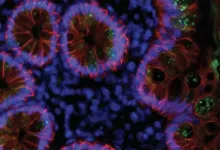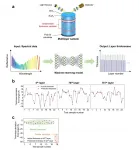(Press-News.org) University of Illinois Chicago is one of the U.S. sites participating in clinical trials to cure severe red blood congenital diseases such as sickle cell anemia or Thalassemia by safely modifying the DNA of patients' blood cells.
The first cases treated with this approach were recently published in an article co-authored by Dr. Damiano Rondelli, the Michael Reese Professor of Hematology at the UIC College of Medicine. The article reports two patients have been cured of beta thalassemia and sickle cell disease after their own genes were edited with CRISPR-Cas9 technology. The two researchers who invented this technology received the Nobel Prize in Chemistry in 2020.
In the paper published in the New England Journal of Medicine, CRISPR-Cas9 Gene Editing for Sickle Cell Disease and β-Thalassemia, researchers reported gene editing modified the DNA of stem cells by deleting the gene BCL11A, the gene responsible for suppressing fetal hemoglobin production. By doing so, stem cells start producing fetal hemoglobin so that patients with congenital hemoglobin defects (beta thalassemia or sickle cell disease) make enough fetal hemoglobin to overcome the effect of the defective hemoglobin that causes their disease.
The advantage of this approach is that it uses the patient's cells with no need for a donor. Also, the gene manipulation does not use a viral vector as with other gene therapy studies but is done with electroporation (quick production of pores into the cells with high voltage) which is known to have low risk of off-target gene activation, according to Rondelli.
Sickle cell disease is an inherited defect of the hemoglobin that causes the red blood cells to become crescent-shaped. These cells can lyse and obstruct small blood vessels, depriving the body's tissues of oxygen. The disease can cause extreme pain and damage the lungs, heart, kidneys and liver. Beta thalassemia is a blood disorder that reduces the production of hemoglobin -- the iron-containing protein in red blood cells that carries oxygen to cells throughout the body. In people with beta thalassemia, low levels of hemoglobin lead to a lack of oxygen in many parts of the body.
The first two patients to receive the treatment have had successful results and continue to be monitored. Rondelli is on the steering committee for an international clinical trial, with UIC being the only site in Chicago. Although the trial is at an early stage and the first patients will be followed for some time before expanding the numbers worldwide, UIC will be among the few sites ready for this treatment.
"It is a great privilege for UIC to be part of this international study and I hope that in the future we will have our own patients undergo this procedure," Rondelli said.
"UIC and UI Health is an ideal place for any cellular therapy in sickle cell disease because of our experience and success in stem cell transplantation in these patients. In fact, over 75% of sickle cell patients can be cured with a transplant, and we have already done over 50 cases," he said.
While a full-match donor is still the first line of treatment, finding a compatible stem cell donor is challenging. For this reason, many centers including UI health have developed strategies to successfully utilize donors who are only 50% compatible, called haploidentical donors. However, according to Rondelli, in about 30% to 50% of the patients, there are still multiple barriers that can limit the possibility of a donor-derived transplant, such as a family donor availability, or the presence of antibodies in the patient caused by many prior red cell transfusions, that would reject the donor stem cells.
"This gene-editing procedure has the potential to overcome all of these. Cells of the same patient can be manipulated and can be transplanted without the risk of rejection or to cause immune reactions from the donor (graft-versus-host disease)," said Rondelli. "For the almost 900 patients with SC coming to our hospital, this should be great news."
Patients who in the future will participate in the trial will have cells sent to the CRISPR manufacturing site where the cells undergo genetic editing. Patients then receive chemotherapy prior to the edited stem cells being re-inserted into their bloodstream.
Researchers hope this treatment can be a game-changer for world health. Sickle cell disease and beta thalassemia and other congenital blood disorders are major diseases in the world. Rondelli said 5 million people only in Nigeria suffer from sickle cell disease, and many others in Africa. Also, currently, 30% of transplants being performed in India, which has 1.3 billion people, are to treat severe beta thalassemia, he added.
"The hope is that this treatment will be accessible and affordable in many low-middle-income countries the Middle East, Africa, and India, and have an important impact in the lives of many people in these areas," said Rondelli.
INFORMATION:
The CRISPR-Cas9 Gene Editing for Sickle Cell Disease and β-Thalassemia research paper was authored by Haydar Frangoul and Jennifer Domm of the Sarah Cannon Center for Blood Cancer at the Children's Hospital at TriStar Centennial, Nashville; Akshay Sharma of St. Jude Children's Research Hospital, Memphis; David Altshuler, Brenda K Eustace, Julie Lekstrom-Himes and Angela Yen of Vertex Pharmaceuticals; Martin Steinberg of Boston University School of Medicine; Yi-Shan Chen, Tony Ho, Andrew Kernytsky and Sandeep Soni of CRISPR Therapeutics, Cambridge, Massachusetts; M. Domenica Cappellini of University of Milan; Franco Locatelli of Ospedale Pediatrico Bambino Gesù Rome, Sapienza, University of Rome; Juergen Foell and Selim Corbacioglu of University of Regensburg, Regensburg, Germany; Rupert Handgretinge of Children's University Hospital, University of Tübingen, Tübingen, Germany; Josu de la Fuente of Imperial College Healthcare NHS Trust, St. Mary's Hospital, London; Stephan Grup of Children's Hospital of Philadelphia, Perelman School of Medicine at the University of Pennsylvania, Philadelphia; Antonis Kattamis of University of Athens, Athens; Amanda Li of BC Children's Hospital, University of British Columbia, Vancouver; Donna Wall of Hospital for Sick Children-University of Toronto; Markus Mapara of Columbia University, New York; Sujit Sheth of Joan and Sanford I. Weill Medical College of Cornell University, New York; Mariane de Montalembert of Necker-Enfants Malades Hospital, Assistance Publique-Hôpitaux de Paris, University of Paris; and Damiano Rondelli, University of Illinois Chicago.
Funded by CRISPR Therapeutics and Vertex Pharmaceuticals; ClinicalTrials.gov numbers, NCT03655678 for CLIMB THAL-111 and NCT03745287 for CLIMB SCD-121.
New research from McMaster University has found that psychiatric help for mothers with postpartum depression results in healthy changes in the brains of their babies.
The study, published in the journal Depression and Anxiety this week, found treating mothers who had postpartum depression with cognitive behavioural therapy (CBT) not only helped the moms, but resulted in adaptive changes in the brains and behaviour of their infants.
More specifically, after the mothers' treatment, their infants showed healthy changes in their nervous and cardiovascular systems, and they were observed to better regulate their behaviours and emotions by both mothers and fathers.
"In fact, we found that after their moms were treated that their infant's ...
As the number of people who have fought off SARS-CoV-2 climbs ever higher, a critical question has grown in importance: How long will their immunity to the novel coronavirus last? A new Rockefeller study offers an encouraging answer, suggesting that those who recover from COVID-19 are protected against the virus for at least six months, and likely much longer.
The findings, published in Nature, provide the strongest evidence yet that the immune system "remembers" the virus and, remarkably, continues to improve the quality of antibodies even after the infection has waned. Antibodies produced ...
BIRMINGHAM, Ala. - University of Alabama at Birmingham polymer and radionuclide chemists report what they say "may represent a major step forward in microcapsule drug delivery systems."
The UAB microcapsules -- labeled with radioactive zirconium-89 -- are the first example of hollow polymer capsules capable of long-term, multiday positron emission tomography, or PET, imaging in vivo. In previous work, UAB researchers showed that the hollow capsules could be filled with a potent dose of the cancer drug doxorubicin, which could then be released by therapeutic ultrasound that ruptures the microcapsules.
PET imaging with zirconium-89 -- which has a half-life of 3.3 days -- allowed the capsules to be traced in test mice up to seven days. The major ...
NASA-funded research on the 11 largest freshwater lakes in the world coupled field and satellite observations to provide a new understanding of how large bodies of water fix carbon, as well as how a changing climate and lakes interact.
Scientists at the Michigan Tech Research Institute (MTRI) studied the five Laurentian Great Lakes bordering the U.S. and Canada; the three African Great Lakes, Tanganyika, Victoria and Malawi; Lake Baikal in Russia; and Great Bear and Great Slave lakes in Canada.
These 11 lakes hold more than 50% of the surface freshwater that millions of people and countless other creatures rely on, underscoring the importance of understanding how they are being altered by climate change and other factors.
The two Canadian lakes ...
BUFFALO, N.Y. -- In the dark waters of Lake Superior, a fish species adapted to regain a genetic trait that may have helped its ancient ancestors see in the ocean, a study finds.
The research focuses on kiyis, which inhabit Lake Superior at depths of about 80 to over 200 meters deep. These fish, known to scientists as "Coregonus kiyi," belong to a group of closely related salmonids known as ciscoes.
In contrast to three other Lake Superior ciscoes that dwell and feed in shallower regions of water, the kiyis are far more likely to carry a version of the rhodopsin gene that probably improves vision in dim "blue-shifted" waters, ...
Curtin University researchers have uncovered a method of making silicon, found commonly in electronics such as phones, cameras and computers, at room temperature.
The new technique works by replacing extreme heat with electrical currents to produce the same chemical reaction that turns silica into silicon at a reduced economic and environmental cost.
Lead researcher, PhD candidate Song Zhang from Curtin's School of Molecular and Life Sciences said that while the team's discovery was made at the nanoscale, it defines a way of replacing thermochemical processes with electrochemical processes, which ...
With the recent explosive demand for data storage, ranging from data centers to various smart and connected devices, the need for higher-capacity and more compact memory devices is constantly increasing. As a result, semiconductor devices are now moving from 2D to 3D. The 3D-NAND flash memory is the most commercially successful 3D semiconductor device today, and its demand for supporting our data-driven world is now growing exponentially.
The scaling law for 3D devices is achieved by stacking more and more semiconductor layers, well above 100 layers, in a more reliable way. As each layer thickness corresponds to the effective channel length, accurate characterization and control of layer-by-layer thickness is critical. To date, ...
Giant ambush-predator worms, possible ancestors of the 'bobbit worm', may have colonized the seafloor of the Eurasian continent around 20 million years ago. The findings, based on the reconstruction of large, L-shaped burrows from layers of seafloor dating back to the Miocene (23 million to 5.3 million years ago) of northeast Taiwan, are reported in Scientific Reports this week.
Ludvig Löwemark and colleagues reconstructed a new trace fossil, which they name Pennichnus formosae, using 319 specimens preserved within layers of seafloor formed during the Miocene era across northeast Taiwan. Trace fossils are geological features such as burrows, track marks and plant root cavities preserved ...
BOSTON - Four years after patients with melanoma were treated with a personalized cancer vaccine, the immune response kindled by the vaccine remains robust and effective in keeping cancer cells under control, researchers at Dana-Farber Cancer Institute, Brigham and Women's Hospital, and the Broad Institute of MIT and Harvard report in a new study.
The findings, published online today by the journal Nature Medicine, demonstrate the staying power of the immune response generated by the vaccine, known as NeoVax, which works by targeting specific proteins on each patient's tumor cells. The researchers found that, nearly four ...
While it has been reported that opioid overdose deaths have increased during the COVID-19 pandemic, a new study looking at data in Philadelphia showed that this hardship has been overwhelmingly suffered by Black individuals. Researchers from the Perelman School of Medicine at the University of Pennsylvania analyzed the period of time after the city's stay-at-home order was announced in 2020 and showed that, compared to the year before, the number of fatal overdoses suffered by Black individuals spiked by more than 50 percent. At the same time, the rate for white individuals actually fell by 31 percent over the same period. This research ...



